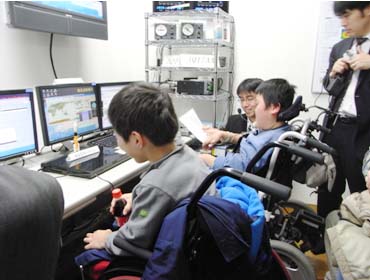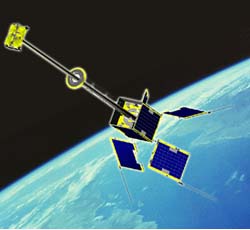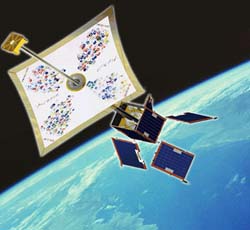Report on Current Status of Small Satellite "Kagayaki"
By Mr. Hiroshi Saegusa, project manager of small satellites (Kagayaki) at Sorun Corp.
Kagayaki was launched as one of six piggyback satellites (small satellites) with the Greenhouse Gases Observing Satellite (GOSAT) "IBUKI" by H-IIA Launch Vehicle No. 15 at 12:54 p.m. on January 23, 2009 (Japan Standard Time) from the Tanegashima Space Center.The main mission of Kagayaki is to connect the dreams of children who have intractable diseases or are disabled, and the dreams of their families, with space.
Consequently, the leading players of the Kagayaki project are those children, and their representatives went to Tanegashima and watched Kagayaki being launched (Fig. 1). It was a great pity that they were not allowed to watch the launch from the observation deck, an area that only persons connected with the launch can enter, close to the launch spot. They had to settle for watching it at an observation spot for the general public far away, some 10 km, from the launch spot, though we were eager to give them a memorable experience by letting them watch the launch as close as possible because some of the children have to use wheelchairs.
On that day, it was fine in the morning but as the launch time approached we had a heavy rainstorm. We watched the launch while worrying about the children's health. The children, however, seemed to be very satisfied, ignoring the staff members' concerns.

(Fig 1) Children and staff members at an observation spot with the launch site in the background.
Kagayaki was scheduled to deploy its solar panel after separating from the vehicle and at the same time deploy its communication antenna, and then to establish a communication link with the ground station. However, we still have not received any signals from Kagayaki even three days after the launch, despite the fact that we could receive a Morse code signal from other small satellites that were launched at the same time.
We tried to receive a signal from Kagayaki using a 24-hour system for all its day and night passes of the three ground stations of Sorun Corp. in Tokyo, Matsumoto, and Miyazaki. And we continued to send a varied series of complex commands to Kagayaki in order to have it deploy its antenna. After that, we purchased some devices and obtained an upgrade license in order to increase our abilities to send commands, and we are now trying to send commands to and receive a signal from Kagayaki.
We are reporting on the latest situation regarding Kagayaki to the children on the website of Soran Corp., and also on March 27 we gave the children a chance to go to the tracking and control center in Tokyo, to experience communicating with the two control centers in Matsumoto and Miyazaki (Fig. 2).
As the present location of Kagayaki is displayed on the basis of NORAD* data at the tracking and control center, the children could imagine Kagayaki and the parachute loaded on it, on which their handprints are printed, flying in space.
We are still going to try to receive radio waves from Kagayaki. And also we will report on the main mission, to conduct activities that connect children's dreams with space, to schools for disabled children who provided their handprints. In addition, we will report on the main mission at the family's camp held every summer, in which children who have intractable diseases or are disabled and more than 30 families (more than 200 hundred people including volunteers) participate.
We think the main mission was very successful since we helped to connect children's dreams with space through our activities. If the children have a strong desire to see Kagayaki-II, we will talk about their space dreams and consider having another go at making and launching a satellite.
*NORAD stands for North American Aerospace Defense Command
NORAD data is information on unidentified space objects (for example launch vehicles, satellites, and space debris). They are always being watched, their trajectories are calculated, and they are assigned individual identifiers by the NORAD

(Fig. 2) Kids tracking group
|
Fig. 3 Shape during operationFig. 4 Parachute for trajectory separation |
|
| Satellite name: | KAGAYAKI* (*KAGAYAKI means "brilliancy" in Japanese) |
| Size: | 31 ?? 31 ?? 305 (cm) |
| Mass: | 208 kg |
| Attitude control: | Gravity-gradient stabilized and 2 magnetic torquers (1 axis) (boom length 2.5 m) |
| Main purpose: | To connect the dreams of disabled children with space |
| Mission: |
|

